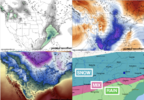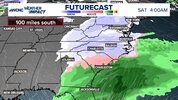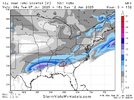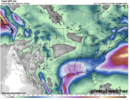 Another Round of Analysis: The Cold Pattern Continues to Dominate
Another Round of Analysis: The Cold Pattern Continues to Dominate
As I’ve been saying for days now, the models have been underestimating the cold air and the potential for a suppressed storm track—and the latest runs are proving that point yet again. While the GFS and Euro continue to act as outliers, models like the UKMET, NAM, GEFS, and Euro AI are showing a much clearer picture of the cold, wintery potential we’ve been tracking. This is exactly the trend I’ve been highlighting, and it’s exciting to see the consensus growing around the colder solution. Let’s dive into the details.
Key Observations
- GFS and Euro Outliers
- The GFS and Euro continue to struggle with the proper handling of the cold air and storm dynamics, showing a warmer, more progressive solution. These models have consistently failed to capture the full extent of the cold air damming (CAD) and its ability to suppress Gulf moisture southward.
- While these solutions cannot be dismissed entirely, their divergence from other models raises questions about their reliability in this particular setup.
- UKMET, NAM, GEFS, and Euro AI Leading the Pack
- These models have shown much better agreement on the critical factors: stronger CAD, a more suppressed Gulf flow, and a colder storm track. This alignment gives more confidence in their solutions, which favor significant snowfall farther south into the Southeast and Mid-Atlantic.
- The UKMET and GEFS, in particular, have consistently trended colder, reflecting the influence of persistent Arctic air and the snowpack across the Midwest.
- Model Agreement Growing
- With the UKMET, NAM, GEFS, and Euro AI largely on the same page, we are seeing a clear trend toward a colder, more amplified solution. This growing model agreement increases confidence in a suppressed storm track that maximizes winter weather potential.
- Colder Ground and Snowpack Impact
- One major factor driving this colder trend is the preexisting snowpack and colder ground temperatures across the Midwest and Plains. These elements enhance the CAD and prevent warm Gulf air from overwhelming the pattern, creating a more favorable setup for snow and wintry precipitation.
What to Expect Moving Forward
- Continued Trends Toward Suppression
- With the stronger CAD and blocking in place, it’s likely that models will continue to suppress the storm track, pushing the snow/mix line farther south. This trend aligns well with the solutions from the UKMET, NAM, GEFS, and Euro AI.
- Snow Zone Expansion
- As models come into better agreement, we may see the snow zone expand farther south into parts of northern Alabama, Georgia, and South Carolina. The suppressed track ensures that these areas remain under colder air, increasing their chances of significant snowfall.
- GFS and Euro Adjustments
- While the GFS and Euro remain outliers for now, there is still time for them to adjust toward the consensus. Historically, both models have been slower to catch onto these types of setups, especially when CAD and suppressed storm tracks are involved.
Final Thoughts
The UKMET, NAM, GEFS, and Euro AI are clearly leading the way in capturing the correct pattern for this storm. Their solutions align with the colder trends we’ve been seeing and paint a much more accurate picture of the winter weather potential. The GFS and Euro, on the other hand, are lagging behind and appear to be outliers at this stage.
If these trends continue, we’re looking at a significant winter storm for the Southeast and Mid-Atlantic, with colder air, suppressed Gulf moisture, and an expanding snow zone. As always, the next few model runs will be crucial, but for now, the colder, snowier solution is gaining momentum—and that’s great news for winter weather enthusiasts!





